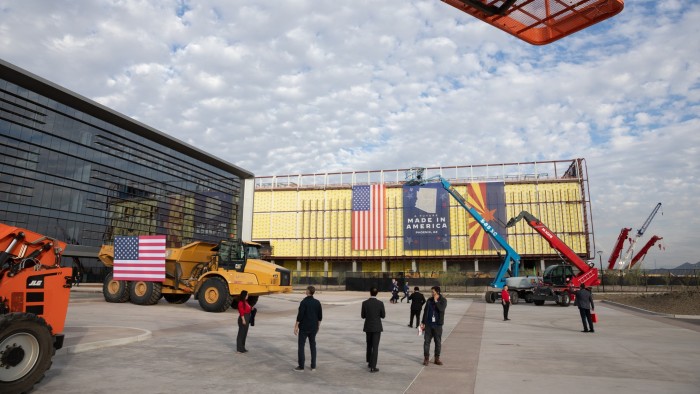Foreign semiconductor companies investing billions of dollars in the US now face an uncertain future — just two years after Congress triggered a boom in the sector by passing the Chips and Science Act to rebuild the country’s long-neglected chip manufacturing industry.
The impending return of Donald Trump to the White House has raised concerns that America’s pitch to become the best place in the world for chipmaking, and reduce its dependence on plants in Asia, could soon ring hollow.
Concerns rose over the future of the programme when the president-elect described the legislation — which includes a historic $39bn subsidy package and tax breaks — as “so bad” in an interview in October. It had won bipartisan support in 2022. Given the pace at which the commerce department has handled applications so far, company executives are wondering how many of the existing proposals will get a green light before the change in leadership in late January.
The Chips Act and its offer of large subsidies to foreign companies is a rarity in US industrial policy and underscores the strategic importance that the Biden administration placed on shifting critical supply chains back to the US. Its aim was to slow China’s progress in developing its own technological and military capabilities.
“You would struggle to find examples of other industrial policies that result in billions of dollars in incentives to foreign firms,” notes Chris Miller, a professor at Tufts University and author of Chip War.
A Peterson Institute study found that spending on the construction of US computer and electronics manufacturing facilities had “skyrocketed” in the last two years, with more electronics construction proceeding in 2024 than in the two previous decades.
This has coincided with a wider stock market frenzy around companies that design chips powering artificial intelligence, such as US-listed Nvidia and Arm.
But rebuilding manufacturing in the US requires participation from companies such as Taiwan Semiconductor Manufacturing Company, the world’s biggest chipmaker, and its South Korean rival Samsung. Martin Chorzempa, who authored the study, points out that these two companies bring not only capital but crucial technical knowledge of one of the most complex manufacturing processes.
He warns of the risks involved in axing the programme. “If the US government rips up these incentive programs, they are going to have a very hard time attracting investment to the US in future.”
Chorzempa adds that critics could use other aspects of the Chips Act to further make their case for scrapping it. He points out that the 25 per cent tax credit available to companies building new semiconductor plants in the US could ultimately exceed the $39bn federal funding package. Such a large allocation of taxpayers money “could become quite politically controversial” over time, he suggests.
Taiwan’s TSMC and GlobalWafers, and South Korea’s Samsung and SK Hynix, are collectively set to receive almost $14bn in grants — a hefty share of the overall subsidy package under the act.
In November, TSMC benefited from the first significant deal to cross the line: $6.6bn in grants and up to $5bn in US government loans. In return, the company, which supplies more than 90 per cent of the world’s most advanced chips, committed to investing $65bn to build three plants in Arizona, one of which is set to start full production in 2025.
However, the majority of the provisional grants announced over the past year have yet to be fully signed off, leaving them vulnerable to an early intervention by the Trump administration.
Since the passage of the act, the US department of commerce has built a team of about 200 staff in its Chips Program Office. Among its key officials is Todd Fisher, formerly of private equity group KKR, who now heads its investment office negotiating the deals.
But industry executives have privately voiced frustration at the department’s approach, expressing surprise at its rigour and complexity. They describe a process akin to corporate dealmaking that involves teams of lawyers working on hundreds of pages of documents.
The red tape includes environmental impact reviews known as ‘NEPA’ assessments, requirements to use union labour and source materials within the US, and specific assurances around employee health and childcare.
“Was it a good idea to push more expensive union labour in construction? I think the answer is probably not,” says Miller — noting the workforce challenges TSMC has faced in Arizona, which resulted in a union settlement over the use of foreign workers.
Executives are hoping there is still time before Trump takes office on 20 January to get more schemes approved. “Once these are signed contracts [rather than non-binding provisional agreements], it will be much harder for the next president to unwind them,” says one industry person close to the discussions.
There are also broader risks for foreign companies investing in the US, not least that “the only way to compete in a higher-wage labour market is to be far more productive than Korea and Taiwan,” says Ben Armstrong, executive director of MIT’s Industrial Performance Center.
He warns it will take time for the US to see any real returns from Biden’s initiative. “You could say the chip boom hasn’t even started yet,” Armstrong says, adding: “The real benefits in growth that could come from it are not likely to pay off until a few years from now.”
Trump’s return now threatens one of the biggest US experiments in industrial policy in decades, and with it the prospects of sustaining the initial boom.
Read the full article here

